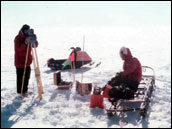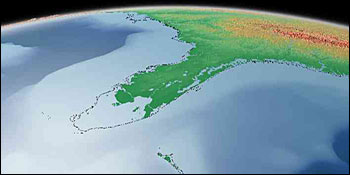| |
 |
| |
Robert Bindschadler stood on a remote stretch of the West Antarctic Ice Sheet
and searched the horizon with a growing sense of anxiety. That is, he couldn’t see the horizon!
While Bindschadler focused on his work—driving flagged poles deep into the ice and carefully
recording their precise coordinates—clouds gathered quickly overhead, cloaking the dazzlingly
bright blue sky in a shroud of sameness that disoriented him. In a matter of minutes the world around
him became a vast featureless white space where he could no longer distinguish sky from surface.
With no shadows and no contrasting color shades, humans lose depth perception. Bindschadler had to
concentrate just to walk without stumbling. He gathered his gear and trudged back to his snowmobile. He
knew it was dangerous to be alone in such conditions so far from base camp. He also knew it was
dangerous to attempt driving back to base camp. The ice held hidden hazards that could claim his life in
an instant. |
|

(Image in title graphic courtesy Nicolas Cullen, Cooperative Institute for
Research in Environmental Sciences) |
| |
 |
| |
“When ice moves rapidly, it can experience stresses large
enough to crack it,” Bindschadler explains. “Some of these cracks, called crevasses, can be
quite large and dangerous—30, 50, even 100 feet deep. Some crevasses are covered by thin bridges of
snow so they are hard to spot.”
Such bridges collapse easily under the weight of a person. “Unless one is roped and connected to
something or someone else, one usually doesn’t survive a fall into a crevasse,” Bindschadler
says in a tone that conveys self-admonishment. He knew better than to allow himself to get caught in
such a predicament. Nevertheless, he faced a difficult decision: hunker down until the weather cleared,
or keep going and risk getting lost in the white-out conditions, or worse, falling into a crevasse.
In hindsight, Bindschadler admits, he should have stopped and dug himself a snow shelter. “Given
that weather conditions can change rapidly in Antarctica, field workers need to always be prepared with
the essentials for survival: food, fuel, and shelter,” he recites. “If you have a shovel,
you can build shelter. If you have food and fuel, you’ll be okay.”
He had a shovel, food, and fuel. Yet there he was astride his snowmobile, in white-out conditions,
squinting ahead at the flat expanse of ice for signs of his previous passage. He felt he would be safe
retracing his path back to base camp. But it was hard to focus and the surface yielded precious few
clues. What would have been a 30-minute trip under clear skies on a beeline back to base camp became a
3-hour meandering ordeal during which Bindschadler constantly second-guessed his decision to keep going.
He heaved a sigh of relief when the shadowy silhouette of base camp finally appeared out of the
whiteness ahead.
Crevasses and rapid, extreme shifts in the weather are just some of the hazards Bindschadler faces in his
work as a glaciologist at NASA’s Goddard Space Flight Center in Greenbelt, Maryland. “A
glaciologist is somebody who studies ice,” he says flatly. Specifically, his job is to measure the
shape of ice sheets. How thick are they? How long are they? Are they growing thicker or thinner? Are
they surging forward to cover more area, or retreating to expose more of the underlying land? How fast
are they moving?
|
|
Antarctica’s environment is extreme and hazardous
for human visitors. The photo on the left shows field workers drilling to measure sea ice thickness. The
middle photo shows an LC-130 Hercules aircraft stuck in a crevasse on Bindschadler Ice Stream in West
Antarctica. The picture on the right shows two field workers out walking in near-white out conditions.
(Photos courtesy Konrad Steffen, Cooperative Institute for Research in Environmental Sciences (left);
Robert Bindschadler, NASA GSFC (center); Waleed Abdalati, NASA GSFC (right)) |
| |
A glaciologist’s goal is to be able to measure the “mass
balance” of a given ice sheet. That is, how much ice the sheet accumulates from snowfall over the
course of a year minus how much it loses due to melt as well as the periodic calving off of large ice
chunks. Ice sheets can be good indicators of what the climate is like in a given region; changes in the
climate can cause changes in Earth’s ice sheets. This simple fact points to the ultimate question
facing glaciologists today: As the globe warms will Antarctica’s ice mass remain in balance? Or,
will the southern continent gain or lose ice mass over time?
When Bindschadler and his colleagues first visited Antarctica in 1980, they brought with them the
traditional wisdom gleaned by generations of explorers and glaciologists before them that large ice
sheets are slow, plodding things that wax and wane on cycles ranging from centuries to millennia. But
the evidence they painstakingly pieced together over the course of 13 expeditions to Antarctica over 25
years suggests that the perceived permanence of Antarctica’s ice sheets is an illusion. They
focused their studies in West Antarctica where the ice sheet is draped over a layer of marine sediments
that is much more slippery than rock. They suspected that this slippery sediment layer and the
above-average amount of subterranean heat the Earth vents in West Antarctica, including numerous
volcanoes, made the West Antarctic Ice Sheet more prone to movement than scientists had previously
thought. |
|

Robert Bindschadler is shown here standing next to a crevasse during snow
survival school on Antarctica in 1988. (Photo courtesy Robert Bindschadler, NASA GSFC) |
| |

Linking Land Ice to Sea Level
Twenty-five years ago glaciologists used standard surveying techniques to measure changes
in ice sheets over time. They would venture out from base camp with sleds full of bamboo poles that they
carefully planted every half a kilometer or so along a straight line. This way they knew what routes
were safe for human passage as well as where and how much the ice was moving. |
|
This RADARSAT map of Antarctica shows key features of the
continent, including the Ross Ice Shelf and the Transantarctic Mountains. (Image courtesy National Snow
and Ice Data Center) |
| |
They used theodolites to monitor the flagpoles’ movements.
(A theodolite is a small, calibrated telescope mounted on a tripod that surveyors use to measure angles
between objects.) Bindschadler’s team became proficient in tracking their own position relative to
magnetic north, relative to the position of the Sun, and relative to those few stars that were visible
in the daytime sky. Once they established their own position, they then measured the relative angles of
all their flagpoles to a tiny fraction of a degree. These measures allowed them to determine how fast
the ice was moving and in what direction, both vertically and horizontally. Bindschadler and his team
were surprised by what they observed.
“When I first got into Antarctic studies, ice sheets were thought to be very slow to respond,”
he recalls. “We had this preconception that any changes would be on scales of centuries. Yet there
were rapid changes taking place. Ice streams would start and stop suddenly. And they are organized in a
vast, interconnected network of streams.” Similar to tributaries on land that flow into larger
rivers, Bindschadler’s team discovered a vast network of coalescing tributaries feeding into ice
streams flowing toward the ocean.
Based on those discoveries and others over the past few decades, glaciologists began to suspect that
Antarctica’s ice sheets are not only sensitive to global warming, but that there could be
observable changes in our lifetime. What does that mean for sea level? Spread across a land area roughly
equal to that of the United States, the southern continent contains about 90 percent of all ice on our
planet. Enough water is locked in ice there to raise global sea level by about 60 meters (197 feet).
Considering that at least one-third of humanity lives in coastal areas, it would be catastrophic should
the ice sheet suddenly and totally collapse. |
|

John Scofield and Dean Lindstrom conducted a theodolite survey in West
Antarctica during the team's deep field expedition in 1983. Before the advent of GPS technology and
modern satellite remote sensors, glaciologists relied mainly on theodolites to track the movements of
glaciers and ice streams over time. (Photo courtesy Robert Bindschadler, NASA GSFC) |
| |
 |
| |
Preposterous! Conventional wisdom says it is inconceivable to melt
Antarctica’s ice fast enough to significantly affect sea level in our lifetime, or even that of
our great grandchildren. So why worry? Antarctica is remote and irrelevant to the lives of ordinary
citizens in the world today, right?
On the contrary, Bindschadler asserts, Antarctica’s ice sheets are entirely relevant. “The
West Antarctic Ice Sheet has, does, and will continue to affect sea level. We know that if this sheet
changes in size, it will change sea level. That connection is direct and irrefutable.”
Over the last 18,000 years, in the wake of the last major Ice Age, Earth’s ice sheets dwindled and
drove sea level up by about 127 meters (381 feet). Paleoclimate data records indicate the rate of sea
level rise varied with the climate; warmer temperatures led to rapid rise while cold spells slowed the
rate of rise. Over the long term, sea level has been rising at an average rate of about 2 millimeters
per year. In the coming decades, as heightened levels of atmospheric greenhouse gases drive up Earth’s
temperatures, how will sea level be affected? Today, locked up in the West Antarctic Ice sheet—roughly
the size of Greenland—is enough water to raise global sea level by another 5 meters (16 feet).
Speaking of Greenland, its ice sheet has seen dramatic melting in the last decade. Greenland contains
about 9 percent of all ice on Earth—also enough water to raise sea level by 5 meters. Should either
West Antarctica or Greenland surrender its ice sheet to the ocean, much of the southern half of Florida
would be under water. |
|
Thermometer measurements of surface air temperature
recorded at many stations around the globe since the 1880s show a gradual rise in temperature over that
span. According to these data, global warming accelerates noticeably in the last 25 years. Colors on
this map show global mean temperature anomaly, or the difference between the long-term average and the
temperature measured at a given time. Reds show warmer-than-average temperature, blues are cooler than
average, and white is average. Gray areas indicate no available data. Notice that warm temperature
anomalies (reds) dominate, and are most extreme at higher latitudes and in the polar regions. (Image by
Robert Simmon, NASA GSFC, based upon data courtesy James Hansen, NASA GISS) |
| |

Today, scientists see serious signs of stress on both ice sheets. Should they both
collapse, sea level will be 10 meters (32 feet) higher, and cartographers will have to redraw the
contours of all Earth’s continents. Neither ice sheet has changed much in recent centuries, but
does that mean they can’t change in the near future?
 A Place of Absolute Stillness A Place of Absolute Stillness
|
|
Should either Greenland or West Antarctica surrender its ice
sheet to the ocean, sea level would rise 5 meters and much of Florida would be underwater. (Illustration
courtesy William Haxby) |

